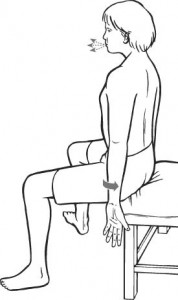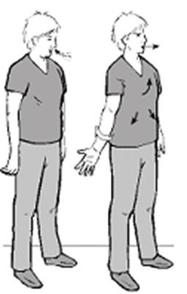| Brugger's Relief Position - Joe Strunk, LMT |
Brugger's Relief Position
Poor daily sitting posture is one of the most common causes of back and neck pain. When you sit for long periods of time, your body rounds forward and puts an enormous strain on the spine and its supporting tendons, ligaments, muscles, and fascia. The muscles in the back and back of the neck fight against gravity to pull you upright thus becoming sore, tired and knotty. The muscles in the front (chest, front of shoulders and front of neck) become shortened and tight. This posture distortion also affects breathing by compressing the diaphragm and encouraging excessive breathing from the shoulder and neck areas.
Benefits: Reduce back and neck strain, reinforces good sitting posture and relaxed breathing.
Frequency: Every 30 minutes during the workday. Hold the posture for 10-20 seconds.
Tips: Focus on keeping the body engaged yet relaxed. As you practice this position, scan your body for tension. As you inhale, feel the air travel through your nose and deep into your belly. Pause. The feel the body relax and the tension lessen with each exhalation.
Frequency: Every 30 minutes during the workday. Hold the posture for 10-20 seconds.
Tips: Focus on keeping the body engaged yet relaxed. As you practice this position, scan your body for tension. As you inhale, feel the air travel through your nose and deep into your belly. Pause. The feel the body relax and the tension lessen with each exhalation.
Performing the Brugger's Relief Position:
|
If sitting:
|
|
If standing:
|
Micro-breaks
Micro-breaks should be performed before you start to feel stiff or sore at your work-site. For most people, this means taking a 20-30 second micro-break every 20-30 minutes of prolonged sitting. Longer breaks of 1-5 minutes should also be taken every 2-3 hours, or as needed. It may be helpful to set reminders on your computer or phone. One of the most effective micro-break exercises is the Brugger's Relief Position developed by a European neurologist. Studies show it will help to reduce tension, improve breathing and improve posture within just a few weeks of practice.


